Which bat species reside at Wildwood?
25th Aug 2023
Authored by Hannah Thomas - a conservationist and Wildwood Devon volunteer based in Somerset.
International Bat Night is held annually to encourage thousands of people across the country to take part in a range of events to connect with the brilliant bat species in their locality. This year, events will be held by local bat groups, and wildlife and conservation organizations across the country to celebrate these remarkable creatures.
Bats have often featured in horror movies and are associated with Hallowe’en and ghost stories. Being nocturnal creatures, they are less commonly seen and look quite different to other animals. As a result, there are lots of ‘popular myths’ about bats that are just silly stories!

True or False?
Bats are blind: False!
Although some rely on echo-location (bouncing sound off their surroundings) to find prey and move around safely in the dark, almost all bats can see.
Bats are flying rats: False!
Bats are not even part of the rodent family, they are more closely related to Apes and humans. They are the only mammals capable of true flight. Their wings are like four long fingers, covered with a ‘skin like’ membrane which is how they got their biological group name Chiroptera- which is Greek for ‘hand wing’.
Bats drink blood: True for South American vampire bat
BUT UK bats ONLY eat insects- many of which (gnats, mosquitos and flies) really would suck your blood if the bats didn’t get them first! Many bats in other countries drink nectar and eat fruit, In fact without bats pollinating crops we would lose out on coffee, mangos, bananas and chocolate. Thank goodness for bats!
Hallowe’en is the time for bats: False!
By the end of October most bats will have started to hibernate as the weather has usually turned chilly.
Bats live in Caves: True for some bats
Here in the UK you will only find some species in caves. Many prefer to be cosied up in attics, unused sheds, crevices in trees or a speciality bat box.
So it turns out, far from being spooky, bats are fascinating animals that play a crucial role in our ecosystem. Not only do they control insect populations but they are also responsible for pollination and, like birds, they are a key indicator species for healthy biodiversity.
Without bats, our world would be a very different place.
IMPORTANT: If you find a sick or ailing bat, you should not approach or handle the animal but seek advice from the Bat Conservation Trust.
Bats at Wildwood
In the UK there are 18 different species of bat. This means bats make up almost a quarter of our mammal species.
At Wildwood Devon, we’ve recorded nine different species of bats in the park alone, many of which are endangered within the UK. To help safeguard these incredible animals, we are creating secure roosting sites to support endangered bat populations during the breeding season and ensure their survival.
Thanks to our recent fundraiser, we now have 40 bat boxes which we will put up across our 45 acre ancient woodland park.
So which bat species inhabit Wildwood Devon?
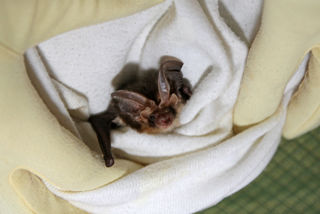
Brown Long-Eared Bat
Size: Medium sized bat 8cm in length including ears
Characteristics: Known as the ‘whispering bat’ due to its’ almost silent echo-location. They use their huge ears and excellent eyesight to find their prey of moths, earwigs, flies and beetles. They eat small prey mid-flight, but take bigger prey to a perch where they eat upside-down.
They are later out of bed than most bats and can live as long as 22 years! Most likely to reach 4 or 5 years old. Hibernate between November and April in tunnels, caves and mines.
Special features: A brown long-eared bat's signature characteristic is its big ears which are almost as long as its body. When resting, it rolls its ears back or hides them underneath its wings. A great way to get a bit of peace and quiet!
Where to find them: Hunting in parks, gardens and woodlands. Roosting in old buildings and trees. Look for them around the Greenhouse at Wildwood.

Common Pipistrelle
Size: Small sized bat with a 20cm wingspan, each bat weighs no more than a pound coin.
Characteristics: Common Pipistrelles' use echolocation to find midges, moths and other flying insects to eat, flying along woodland edges and near water. They form maternity roosts to rear just one pup each and hibernate between November and April in buildings.
Special features: Common pipistrelles normally breed in autumn and winter, but will not give birth until the following summer. During the breeding season, males fly whilst emitting high-pitched calls – a sort of singing – to attract the attention of females.
Where to find them: Normally roost in buildings, bat boxes and roof spaces of houses. You may see them around street lights just after sunset. Look for them around the front lawn of Escot House.
Photo credit: Flickr JP
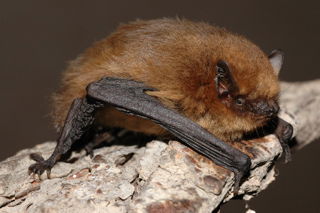
Soprano Pipistrelle
Size: Smaller sized bat, 3-8g in weight.
Characteristics: Soprano Pipistrelles' use echolocation to find small flies, moths, midges & mosquitoes. They often hunt along wooded rivers and over water, catching prey in mid-flight and eating on the wing. A single soprano pipistrelle can eat up to 3,000 insects in one night. Also form maternity colonies and have just one pup.
Special features: The soprano pipistrelle was only identified as a separate species from the common pipistrelle in the 90s. The most reliable way to distinguish the species is by the frequency of their echolocation calls. Sporanos have very large, noisy maternity colonies!
Where to find them: The species occurs throughout the UK with the exception of the very north of Scotland. Keep an eye out for this species near lakes and rivers, as this is where they are most likely to be seen feeding . Also look for these around the front lawn of Escot House.
Photo credit: Wikipedia
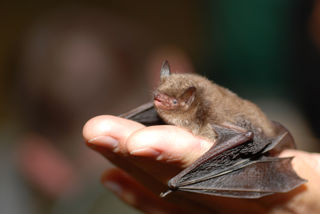
Daubenton's Bat
Size: Medium sized bat weighing up to 15g (slightly less than a robin) and have a wingspan of around 25cm.
Characteristics: Known as the water bat. They have reddish-brown fur and pink faces. Often roost near water, under bridges or in tunnels, and in holes in trees. They usually hibernate underground over winter, in caves, tunnels and mines.
Special features: The prize for water sports goes to this bat! The Daubenton’s bat uses its hairy feet or tail to capture midges and mayflies off the water surface in a fly-by move.
Where to find them: Your best chance of seeing a Daubenton’s Bat is to watch a body of open, fresh water at dawn or dusk. If you’re lucky, you may see the bats swooping down over the water in search of prey. Look for them around our wetlands and around Escot Lake.
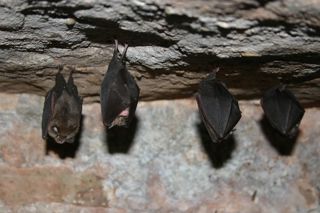
Lesser Horseshoe Bat
Size: One of our smallest bats, weighing about a third as much as a greater horseshoe. With folded wings, it is about the size of a plum.
Characteristics: The Lesser Horseshoe Bat tends to roost in caves, old houses, churches, stables and barns. Like the Greater Horseshoe Bat, it has a characteristically fleshy nose that is shaped like a horseshoe focusing the bats echolocation pulses making it easier to find its prey of midges, small moths, caddis flies, lacewings, beetles, small wasps and spiders.
Special features: Lesser Horseshoe Bats hunt close to the ground and often snatch their prey off stones and branches. They also have long lifespans and have been known to live up to 30 years!
Where to find them: Woodland, pastured and wetlands. Look for them by the icehouse from our black run path over the bridge at Wildwood Devon.
Photo credit: Flickr - Jessicajil

Greater Horseshoe Bat
Size: One of our largest bats, the greater horseshoe bat is the size of a small pear, with a wingspan of up to 40cm.
Characteristics: Like the Lesser Horseshoe Bat, the Greater Horseshoe Bat also roosts in caves, old houses, churches, stables and barns. Its characteristically fleshy nose, shaped like a horseshoe makes it easier to find its prey of Moths, beetles, caddisflies, craneflies and gnats. It has golden brown fur, round wings, beady black eyes and leaf shaped pointy ears.
Special features: They often choose a regular perch in a tree or cave from which they can watch for passing insects; when they spot their prey, they fly out to catch it in the air. They are sadly one of the rarest bats in the UK due to loss of habitat and insects.
Where to find them: Woodland edges at dawn and dusk. Look for them by Escot House.
Photo credit: Flickr - S. Reboleira
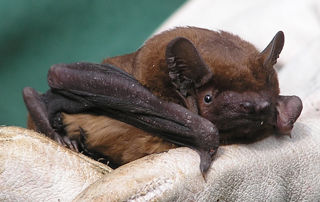
Noctule Bat
Size: The largest bat, in the UK, weighing up to 40g and with a wingspan of up to 40cm.
Characteristics: It has golden-brown fur with a darker brown face and wings. Its small, rounded ears are also dark brown and have a mushroom-shaped tragus (the bit of flesh in front of the ear canal). Often seen flying high above the trees, the Noctule uses its powerful flight to dive and catch moths, winged ants, midges and flying beetles on the wing. The male finds a tree hole to be his mating roost and attempts to attract a mate using a range of shrill calls and by producing a strong odour during flight.
Special features: Noctule calls can heard by some adults and children and are often mistaken for Swifts due to their high flying and swooping!
Where to find them: Woodlands above the tree canopy. Look around the squirrel, lynx and wild boar enclosures, Escot lake and around the front lawn of Escot House
Photo credit: Flickr - Dave
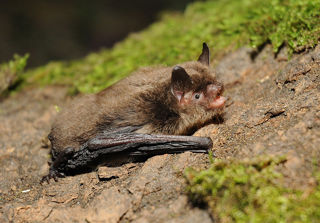
Whiskered Bat
Size: Small sized bat, weighing up to 8g with a wingspan of up to 24cm.
Characteristics: This bat is a crevice dweller, often roosting around house roofs- hanging tiles, above soffits, in cavity walls and under ridge tiles. It has dark shaggy fur. It is similar in appearance to the Brandt’s bat but is slightly smaller with different shaped teeth and ears. Colonies of whiskered and Brandt’s bats may use separate parts of the same roof and may also roost with pipistrelles or long-eared bats. They will also roost in trees and churches, and have been known to use bat boxes.
Special features: They have a very fast and fluttering flight. Although they prey on moths and spiders, they may be more flexible in terms of what they will eat than other bats.
Where to find them: Hedgerows and woodland edges. Look around the bear and wildcat enclosures at Wildwood Devon.
Photo credit: Flickr - Ján Svetlík
